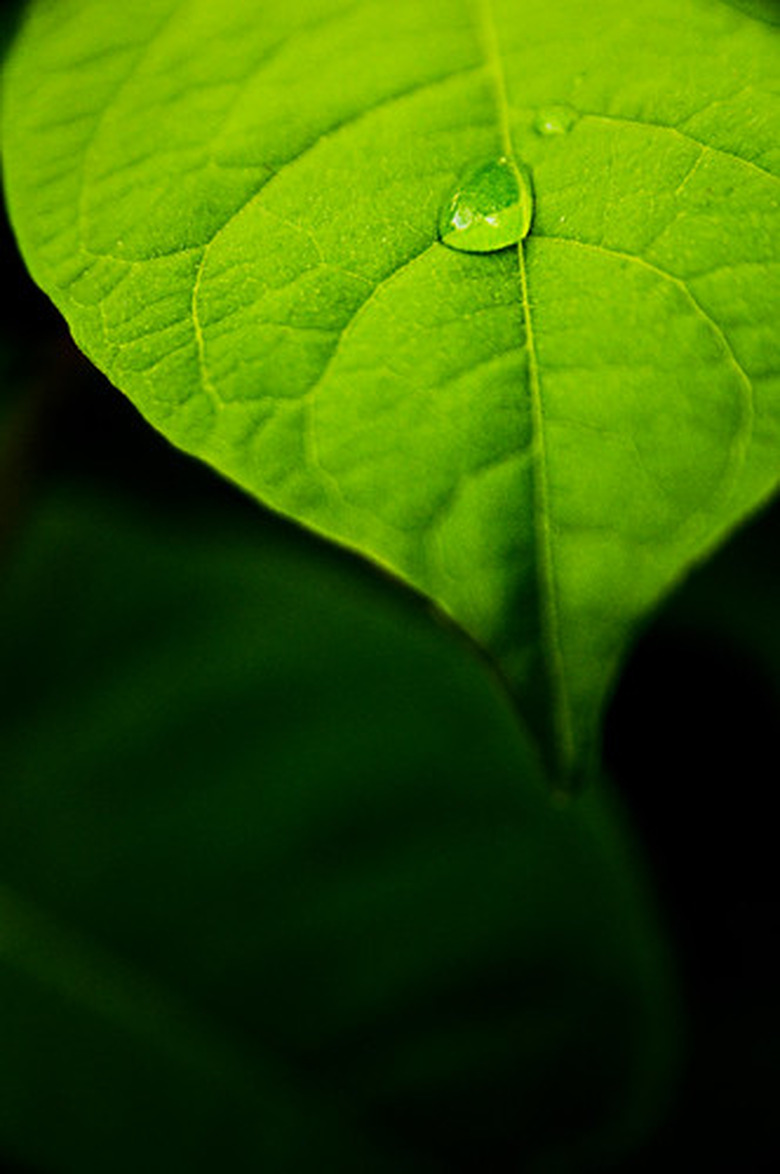How Is The Leaf Adapted For Photosynthesis?
The leaf has evolved, special parts to conduct photosynthesis, a process that uses energy from the sun to turn carbon dioxide and water into sugars needed for plant growth. Six molecules of water plus six molecules of carbon dioxide from the air yields one molecule of useful sugar plus six molecules of oxygen. The most important botanical adaptations by the leaf to conduct photosynthesis are the stoma, guard cells, mesophyll cells and veins.
Stomata
The exterior of the leaf, the epidermis, is ordinarily protected by a waxy covering called the cuticle. Leaf pores, called stomata (plural of stoma) are surrounded by guard-cells.
Carbon dioxide can't pass through the cuticle, but can enter through stomata. Oxygen produced by photosynthesis passes out of the leaf through stomata. As oxygen moves through the interior of the leaf and exits though the stomata, the plant loses water; this is called expiration.
- The leaf has evolved, special parts to conduct photosynthesis, a process that uses energy from the sun to turn carbon dioxide and water into sugars needed for plant growth.
- The most important botanical adaptations by the leaf to conduct photosynthesis are the stoma, guard cells, mesophyll cells and veins.
Guard Cells
The guard cells flanking stomata control the oxygen and carbon dioxide entering the leaf by opening and closing the leaf pores. In some plants they can do this quite rapidly.
Mesophyll
Mesophyll tissue is located in the interior of the leaf between the upper and lower layers of the epidermis, the top and bottom of the leaf. Mesophyll contains chloroplast cells, proteins that conduct photosynthesis.
Long, round chloroplast cells form the palisade layer just below the top of the leaf. The cells in this layer are arranged in one to five rows. They are separated so they can absorb carbon dioxide, but are not so far apart as to inhibit capillary action needed to distribute water in the interior of the leaf. The palisade layer contains the most chloroplasts, so most photosynthesis occurs there.
- The guard cells flanking stomata control the oxygen and carbon dioxide entering the leaf by opening and closing the leaf pores.
- Long, round chloroplast cells form the palisade layer just below the top of the leaf.
Beneath the palisade layer, and above the bottom of the leaf, the spongy layer contains fewer chloroplasts that are more rounded and have large spaces between them.
The Veins
The veins of a leaf contain a bundle of vascular tubes called xylem that transport water and minerals from the roots to the stems, from the stems to the leaf and to different parts of the leaf where they are needed for photosynthesis.
The sugars made during photosynthesis are transported throughout the plant through tubes called phloem.
When Light Hits Leaves
Light comes in the form of particles that are separated by wave lengths. Each color has a different wave length. Colors are more red as the length of the wave increases. Any substance that absorbs light is called a pigment. Chlorophyll, a complex pigment, absorbs all visible light except green, which it reflects and which is why leaves are green.
- Beneath the palisade layer, and above the bottom of the leaf, the spongy layer contains fewer chloroplasts that are more rounded and have large spaces between them.
Three things can happen when a pigment absorbs light: the energy dissipates as heat; the pigment emits a longer wavelength, a phenomenon known as fluorescence, or it can trigger a chemical reaction.
When light hits chlorophyll in a leaf, the chlorophyll triggers chloroplast cells in the mesophyll. The chloroplast cells split water, release oxygen and add hydrogen to carbon to form carbohydrates that the plant turns into sugar.
